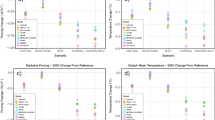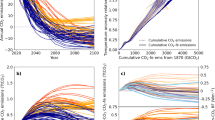Abstract
Minimizing the future impacts of climate change requires reducing the greenhouse gas (GHG) load in the atmosphere. Anthropogenic emissions include many types of GHG’s as well as particulates such as black carbon and sulfate aerosols, each of which has a different effect on the atmosphere, and a different atmospheric lifetime. Several recent studies have advocated for the importance of short timescales when comparing the climate impact of different climate pollutants, placing a high relative value on short-lived pollutants, such as methane (CH4) and black carbon (BC) versus carbon dioxide (CO2). These studies have generated confusion over how to value changes in temperature that occur over short versus long timescales. We show the temperature changes that result from exchanging CO2 for CH4 using a variety of commonly suggested metrics to illustrate the trade-offs involved in potential carbon trading mechanisms that place a high value on CH4 emissions. Reducing CH4 emissions today would lead to a climate cooling of approximately ~0.5 °C, but this value will not change greatly if we delay reducing CH4 emissions by years or decades. This is not true for CO2, for which the climate is influenced by cumulative emissions. Any delay in reducing CO2 emissions is likely to lead to higher cumulative emissions, and more warming. The exact warming resulting from this delay depends on the trajectory of future CO2 emissions but using one business-as usual-projection we estimate an increase of 3/4 °C for every 15-year delay in CO2 mitigation. Overvaluing the influence of CH4 emissions on climate could easily result in our “locking” the earth into a warmer temperature trajectory, one that is temporarily masked by the short-term cooling effects of the CH4 reductions, but then persists for many generations.


Similar content being viewed by others
References
Allen MR, Frame DJ, Huntingford C, Jones CD, Lowe JA, Meinshausen M, Meinshausen N (2009) Warming caused by cumulative carbon emissions towards the trillionth tonne. Nature 458(7242):1163–1166. doi:10.1038/nature08019
Archer D, Brovkin V (2008) The millennial atmospheric lifetime of anthropogenic CO2. Clim Chang 90(3):297. doi:10.1007/s10584-008-9413-1
Azar C, Johansson DJA (2012) On the relationship between metrics to compare greenhouse gases – the case of IGTP, GWP and SGTP. Earth Syst Dynam 3(2):139–147. doi:10.5194/esd-3-139-2012
Berntsen T, Tanaka K, Fuglestvedt JS (2010) Does black carbon abatement hamper CO(2) abatement? A letter. Clim Chang 103(3–4):627–633
Daniel J, Solomon S, Sanford T, McFarland M, Fuglestvedt J, Friedlingstein P (2012) Limitations of single-basket trading: lessons from the Montreal Protocol for climate policy. Clim Chang 111(2):241–248. doi:10.1007/s10584-011-0136-3
Davis SJ, Caldeira K, Matthews HD (2010) Future CO(2) emissions and climate change from existing energy infrastructure. Science 329(5997):1330–1333. doi:10.1126/science.1188566
Derwent RG (1990) Trace gases and their relative contribution to the greenhouse effect. Atomic Energy Research Establishment, Document: AERE R 13716, Harwell
Fisher DA, Hales CH, Wang W-C, Ko MKW, Sze ND (1990) Model calculations of the relative effects of CFCs and their replacements on global warming. Nature 344:513–516
Forster P, Ramaswamy V, Artaxo P, Berntsen T, Betts R, Fahey DW, Haywood J, Lean J, Lowe DC, Myhre G, Nganga J, Prinn R, Raga G, Schulz M, Dorland RV (2007) Changes in atmospheric consituents and in radiative forcing. paper presented at the climate change 2007: the physical science-basis. Contribution of Working Group 1 to the Fourth Assessment Report of the Intergovernmental Panel on Climate Change
Fuglestvedt JS, Berntsen TK, Godal O, Skodvin T (2000) Climate implications of GWP-based reductions in greenhouse gas emissions. Geophys Res Lett 27(3):409–412. doi:10.1029/1999gl010939
Fuglestvedt JS, Berntsen TK, Godal O, Sausen R, Shine KP, Skodvin T (2003) Metrics of climate change: assessing radiative forcing and emission indices. Clim Chang 58(3):267–331. doi:10.1023/a:1023905326842
Fuglestvedt JS, Shine KP, Berntsen T, Cook J, Lee DS, Stenke A, Skeie RB, Velders GJM, Waitz IA (2010) Transport impacts on atmosphere and climate: metrics. Atmos Environ 44(37):4648–4677. doi:10.1016/j.atmosenv.2009.04.044
Gillett NP, Matthews HD (2010) Accounting for carbon cycle feedbacks in a comparison of the global warming effects of greenhouse gases. Environ Res Lett 5(3). doi:10.1088/1748-9326/5/3/034011
Hammitt JK, Jain AK, Adams JL, Wuebbles DJ (1996) A welfare-based index for assessing environmental effects of greenhouse-gas emissions. Nature 381:301–303
Hansen J, Sato M, Ruedy R, Lacis A, Oinas V (2000) Global warming in the twenty-first century: an alternative scenario. Proc Natl Acad Sci 97(18):9875–9880
Howarth RW, Santoro R, Ingraffea A (2011) Methane and the greenhouse-gas footprint of natural gas from shale formations. Clim Chang 106(4):679–690. doi:10.1007/s10584-011-0061-5
Howarth R, Santoro R, Ingraffea A (2012) Venting and leaking of methane from shale gas development: response to Cathles et al. Clim Chang 113(2):537–549. doi:10.1007/s10584-012-0401-0
Humbert R (2010) Losing time, not buying time. http://www.realclimate.org/index.php/archives/2010/12/losing-time-not-buying-time/
Joos F, Roth R, Fuglestvedt JS, Peters GP, Enting IG, von Bloh W, Brovkin V, Burke EJ, Eby M, Edwards NR, Friedrich T, Frölicher TL, Halloran PR, Holden PB, Jones C, Kleinen T, Mackenzie FT, Matsumoto K, Meinshausen M, Plattner GK, Reisinger A, Segschneider J, Shaffer G, Steinacher M, Strassmann K, Tanaka K, Timmermann A, Weaver AJ (2013) Carbon dioxide and climate impulse response functions for the computation of greenhouse gas metrics: a multi-model analysis. Atmos Chem Phys 13(5):2793–2825. doi:10.5194/acp-13-2793-2013
Kriegler E, Hall JW, Held H, Dawson R, Schellnhuber HJ (2009) Imprecise probability assessment of tipping points in the climate system. Proc Natl Acad Sci 106(13):5041–5046
Lashof DA, Ahuja DR (1990) Relative contributions of greenhouse gas emissions to global warming. Nature 344(6266):529–531
Manne AS, Richels RG (2001) An alternative approach to establishing trade-offs among greenhouse gases. Nature 410(6829):675–677
O'Neill B (2000) The jury is still out on global warming potentials. Clim Chang 44(4):427–443. doi:10.1023/a:1005582929198
Peters GP, Aamaas B, Berntsen T, Fuglestvedt JS (2011) The integrated global temperature change potential (iGTP) and relationships between emission metrics. Environ Res Lett 6(4). doi:10.1088/1748-9326/6/4/044021
Prather M, Derwent R, Ehhalt D, Fraser P, Sanhueza E, Zhou X (1994) Other trace gases and atmospheric chemistry. Climate Change 94:77–126
Ramanathan V, Xu Y (2010) The Copenhagen accord for limiting global warming: criteria, constraints, and available avenues. Proc Natl Acad Sci 107(18):8055–8062
Schrag DP (2012) Is shale gas good for climate change? Daedalus 141(2):72–80. doi:10.1162/DAED_a_00147
Shindell DT, Faluvegi G, Koch DM, Schmidt GA, Unger N, Bauer SE (2009) Improved attribution of climate forcing to emissions. Science 326(5953):716–718. doi:10.1126/science.1174760
Shindell D, Kuylenstierna JCI, Vignati E, van Dingenen R, Amann M, Klimont Z, Anenberg SC, Muller N, Janssens-Maenhout G, Raes F, Schwartz J, Faluvegi G, Pozzoli L, Kupiainen K, Hoglund-Isaksson L, Emberson L, Streets D, Ramanathan V, Hicks K, Oanh NTK, Milly G, Williams M, Demkine V, Fowler D (2012) Simultaneously mitigating near-term climate change and improving human health and food security. Science 335(6065):183–189. doi:10.1126/science.1210026
Shine K (2009) The global warming potential—the need for an interdisciplinary retrial. Clim Chang 96(4):467–472. doi:10.1007/s10584-009-9647-6
Shine KP, Fuglestvedt JS, Hailemariam K, Stuber N (2005) Alternatives to the global warming potential for comparing climate impacts of emissions of greenhouse gases. Clim Chang 68(3):281–302. doi:10.1007/s10584-005-1146-9
Shine KP, Berntsen TK, Fuglestvedt JS, Skeie RB, Stuber N (2007) Comparing the climate effect of emissions of short- and long-lived climate agents. Phil Trans R Soc A Math Phys Eng Sci 365(1856):1903–1914. doi:10.1098/rsta.2007.2050
Socolow R, Desmond M, Aines R, Blackstock J, Bolland O, Kaarsberg T, Lewis N, Mazzotti M, Pfeffer A, Sawyer K, Siirola J, Smit B, Wilcox J (2011) Direct air capture of CO2 with chemicals. American Physical Society
Solomon S, Pierrehumbert RT, Matthews DL, Daniel JS (2011) Atmospheric Composition Irreversible Climate Change and Mitigation Policy. WCRP OSC Climate Research in Service to Society (24–28 October 2011. Denver, United States
Tanaka K, O’Neill BC, Rokityanskiy D, Obersteiner M, Tol RSJ (2009) Evaluating Global Warming Potentials with historical temperature. Clim Chang 96(4):443–466. doi:10.1007/s10584-009-9566-6
Wigley TML (1998) The Kyoto Protocol: CO2, CH4 and climate implications. Geophys Res Lett 25(13):2285–2288. doi:10.1029/98gl01855
Wigley TML (2008) MAGICC/SCENGEN 5.3: user manual (version 2). . UCAR Climate and Global Dynamics Division
Wigley TML, Richels R, Edmonds JA (1996) Economic and environmental choices in the stabilization of atmospheric CO2 concentrations. Nature 379(6562):240–243
Wigley T, Raper S, Salmon M, Hulme M (1997) MAGICC: Model for the Assessment of Greenhouse-gas Induced Climate Change: Version 2.3. Climatic Research Unit, Norwich, United Kingdom
Wuebbles DJ (1989) Beyond CO2—the other greenhouse gases. Lawrence Livermore National Laboratory report UCRL-99883; Air and Waste Management Association paper 89–119.4
Acknowledgements
We recognize the substantial contributions of three anonymous reviewers to the quality of this manuscript. Conversations with V. Ramanathan and M. Molina contributed to our understanding of these topics.
Author information
Authors and Affiliations
Corresponding author
Electronic supplementary material
Below is the link to the electronic supplementary material.
ESM 1
(DOCX 301 kb)
Rights and permissions
About this article
Cite this article
Shoemaker, J.K., Schrag, D.P. The danger of overvaluing methane’s influence on future climate change. Climatic Change 120, 903–914 (2013). https://doi.org/10.1007/s10584-013-0861-x
Received:
Accepted:
Published:
Issue Date:
DOI: https://doi.org/10.1007/s10584-013-0861-x




